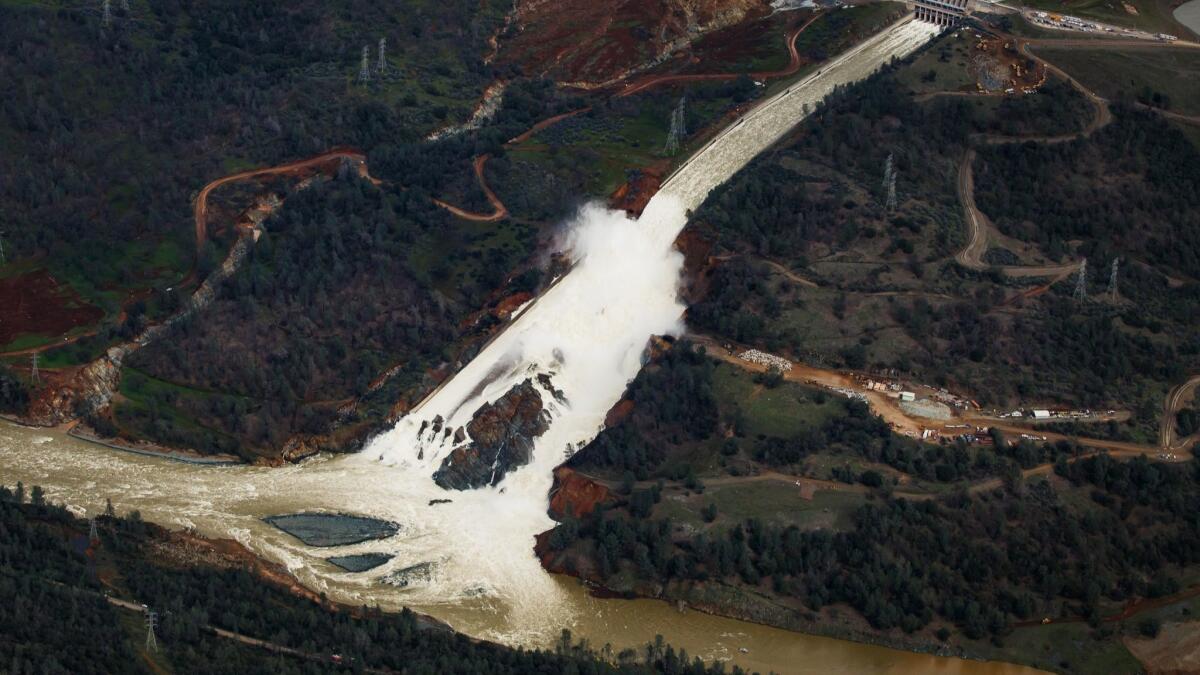After near-disaster, Oroville Dam spillway about to face its first big test

Two years ago the city of Oroville stood in awe as millions of gallons of water eroded the main spillway of the nation’s largest dam, sending a deluge of water cascading down a hillside and forcing thousands of residents to evacuate.
Now that the bulk of the repairs on Oroville Dam have been completed, its concrete spillway could face its first major test as early as next week. Officials predict they might need to open the gates to move water that accumulated during the wet winter season from the reservoir down into the Feather River.
The reservoir, a key stockpile of California’s water supply, has risen significantly following several storms in the past month and is currently at 845 feet. That is still more than 50 feet below the top of the lake, but it is near the level where some water should be released to maintain capacity for future runoff from storms and, eventually, melting snow from the Sierra Nevada.
“You want to keep the lake rising slowly,” said Erin Mellon, a spokeswoman for the California Department of Water Resources. “What you’re balancing is water supply with flood protection. What you don’t want to do is have the lake totally full and then have a really wet system come through. California’s weather is so variable and so unpredictable that we have to plan for all of these different scenarios.”
With a rainstorm set to arrive in Butte County on Thursday that’s expected to drop up to an inch of precipitation, and another storm on the horizon, officials predict water releases could begin as early as next week. Mellon said the agency will give the public at least a day’s notice before using the spillway.
The area surrounding the reservoir has received nearly 37 inches of rain since October, pushing the region to 150% of normal for the water year, according to the National Weather Service. The water year runs from Oct. 1 through Sept. 30.
To prepare for the spillway’s use, water officials are removing construction equipment from the area and taking out a temporary road below the spillway. They also plan to install temporary cameras and lights along the spillway for observation when water begins to flow down the chute.
Officials are confident the newly reinforced infrastructure will work as intended when the time comes.
“We’ve used all the best available science and data and engineering practices of the day,” Mellon said.
The massive spillway reconstruction effort, which cost more than $1 billion, required pouring more than 1.2 million cubic yards of concrete — enough to fill 372 Olympic-sized swimming pools. The main spillway alone contains enough concrete to build a sidewalk from Oroville to Amarillo, Texas.
Amy Rechenmacher, an associate professor of engineering practice at USC, said the spillway’s use is going to be a big test for the agency and engineers who worked on the project.
“Hopefully they did a good job with the redesign and it’ll work and everybody will be happy,” she said. “If it doesn’t, I think that will be a wake-up call and everybody will review their spillways to see what needs to be done.”
The reconstructed spillway can handle water flowing at a rate of 270,000 cubic feet per second, which Mellon said is much greater than the amount officials would ever expect to release at a time.
Water was flowing at a rate of 50,000 cubic feet per second when the spillway began disintegrating on Feb. 7, 2017, after a deluge in the Feather River watershed filled the 50-year-old reservoir and forced operators to open the spillway gates.
When the main spillway failed, an adjacent emergency spillway that at the time was nothing more than an earthen hill was used. The hillside quickly eroded, which forced 188,000 people downriver in Butte County to flee out of concern the concrete lip of the dam would fail and send a 30-foot wall of water down the Feather River into the community.
An analysis of the cause behind the main spillway’s failure pointed to a series of questionable decisions during construction, including relying on relatively thin layers of concrete around vital joints, poor drainage for water that seeped into the chute and weak reinforcements.
The investigation found that the rock base under the spillway was less stable than designers thought, which was made clear when the water scoured deep bowls into the hillside after the concrete was washed away.
A report released in January 2018 by an independent forensic team organized by the Assn. of State Dam Safety Officials contended that the dam’s owner, the Department of Water Resources, was “significantly overconfident and complacent about the integrity of its State Water Project civil infrastructure, including dams.”
The report found that periodic inspections of the spillway failed to identify the original design flaws and the subsequent deterioration of the spillway’s integrity.
Butte County Dist. Atty. Mike Ramsey, whose office is suing the Department of Water Resources over alleged damage to the river stemming from the 2017 incident, said the community feels a “modicum of comfort” in the fact the spillway has been reconstructed.
“There’s still some concern in the back of everyone’s minds after all that’s come out in the last couple of years,” Ramsey said.
Twitter: @Hannahnfry
More to Read
Sign up for Essential California
The most important California stories and recommendations in your inbox every morning.
You may occasionally receive promotional content from the Los Angeles Times.











